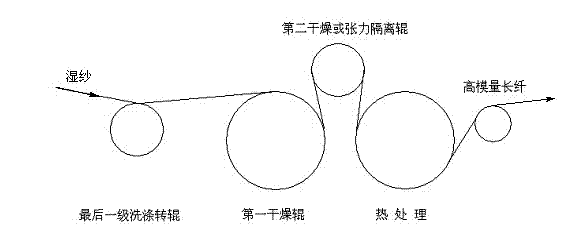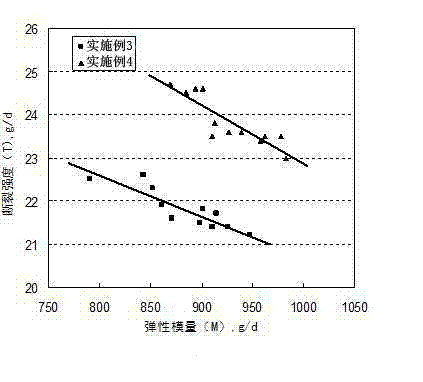High-modulus poly(p-phenylene terephthalamide) (PPTA) fiber and preparation method thereof
A technology of poly-p-phenylene terephthalamide and phthaloyl-p-phenylene diamine is applied in the field of high-modulus poly-p-phenylene terephthalamide fiber and its preparation field, and can solve the difficulty of fiber technology , affecting industrial efficiency and other issues, to achieve the effect of a wide range of applications, low industrial costs, and good performance
- Summary
- Abstract
- Description
- Claims
- Application Information
AI Technical Summary
Problems solved by technology
Method used
Image
Examples
Embodiment 1
[0051] This example describes the preparation of polyparaphenylene terephthalamide (PPTA) polymer by low temperature solution polycondensation method
[0052] A. Preparation of raw materials
[0053] P-phenylene diamine [PPD],
[0054] Terephthaloyl chloride [TPC],
[0055] The solvent is (N-methyl pyrrolidone)[NMP],
[0056] The co-polysalt (ie co-solvent) is calcium chloride (CaCl 2 );
[0057] Among them: the molar ratio of PPD / TPC is equal to 1.0, and CaCl 2 The molar ratio of / PPD is equal to 1.2, and the solid content of the polymerization mixture is 9%;
[0058] B. Polymerization of raw materials
[0059] Pour nitrogen into the oven after drying, and then add dry NMP / CaCl 2 Solvent and dry high-purity p-phenylenediamine (PPD), turn the stirrer, and mix well, activate the chilled water jacket of the reactor, gradually dissolve the mixture of p-phenylenediamine PPD and solvent NMP and cool down within 1 minute To 20℃, then add a total of 30 % Terephthaloyl chloride (TPC), continue...
Embodiment 2
[0060] Example 2 Spinning process of dry jet wet spinning process
[0061] The polyparaphenylene terephthalamide (PPTA) polymer with a logarithmic viscosity of 6.5dL / g prepared in Example 1 was added to sulfuric acid with a concentration of 99.8%, and the mixture was stirred vigorously and heated to 80°C. A spinning pulp with a concentration of 19.4% is formed. After filtration, the slurry is metered by a gear pump and sprayed from the spinneret; the spinneret has 1000 spinning holes with a hole diameter of 0.063mm. The spinning pulp is sprayed out of the spinning holes to form a pulp The silk passes through a 6mm air layer, enters the surface of the coagulation solution, and then passes through the coagulation tube in the center of the coagulation tank, and flows out from the bottom of the tube. The coagulation bath temperature is 4℃, and the acid content of the coagulation liquid is 10%. The sulfuric acid contained in the sizing has been partially extracted to become a wet ...
Embodiment 3
[0062] Example 3 Heat treatment process
[0063] The dry filament yarn obtained in Example 2 is subjected to heat treatment outside the spinning line, such as figure 2 As shown, the specific process includes: heating a long pipe with an electric furnace, controlling the temperature of the heat pipe wall to 400, 425, 450, 475 ℃, passing the dry yarn through the heat pipe, and absorbing the heat pipe radiant heat to increase the temperature, and the tension is 3, 5. 7 g / denier, the residence time is 7 seconds, the performance of the obtained long yarn after heat treatment is shown in Table 2.
[0064] Table 2 Mechanical properties and fiber properties before and after the warp heat treatment
[0065]
[0066] It can be seen from Table 2 that although the heat-treated fiber has a higher modulus, its strength is slightly lower than that of the original spun fiber.
PUM
| Property | Measurement | Unit |
|---|---|---|
| Logarithmic viscosity | aaaaa | aaaaa |
Abstract
Description
Claims
Application Information
 Login to View More
Login to View More - R&D
- Intellectual Property
- Life Sciences
- Materials
- Tech Scout
- Unparalleled Data Quality
- Higher Quality Content
- 60% Fewer Hallucinations
Browse by: Latest US Patents, China's latest patents, Technical Efficacy Thesaurus, Application Domain, Technology Topic, Popular Technical Reports.
© 2025 PatSnap. All rights reserved.Legal|Privacy policy|Modern Slavery Act Transparency Statement|Sitemap|About US| Contact US: help@patsnap.com



